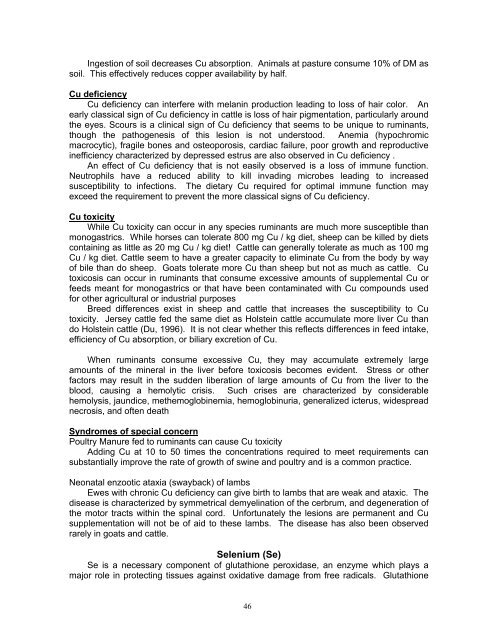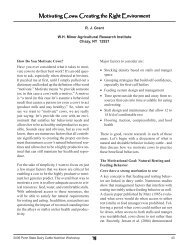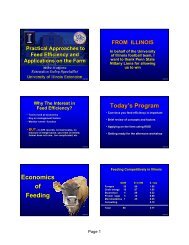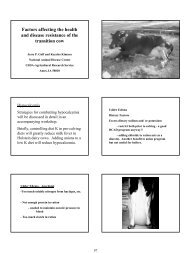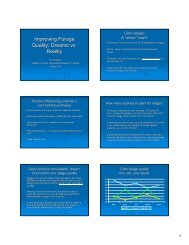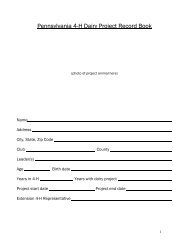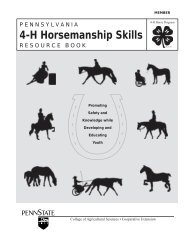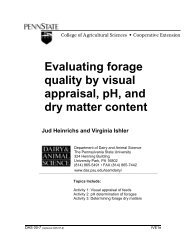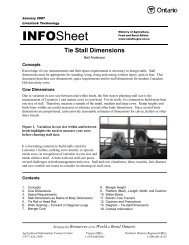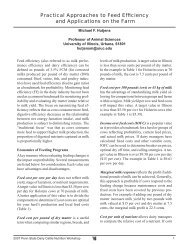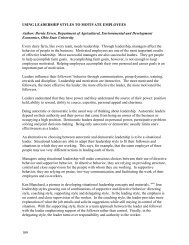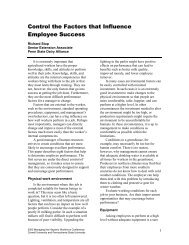DETERMINING THE MINERAL REQUIREMENT OF DAIRY CATTLE
DETERMINING THE MINERAL REQUIREMENT OF DAIRY CATTLE
DETERMINING THE MINERAL REQUIREMENT OF DAIRY CATTLE
You also want an ePaper? Increase the reach of your titles
YUMPU automatically turns print PDFs into web optimized ePapers that Google loves.
Ingestion of soil decreases Cu absorption. Animals at pasture consume 10% of DM as<br />
soil. This effectively reduces copper availability by half.<br />
Cu deficiency<br />
Cu deficiency can interfere with melanin production leading to loss of hair color. An<br />
early classical sign of Cu deficiency in cattle is loss of hair pigmentation, particularly around<br />
the eyes. Scours is a clinical sign of Cu deficiency that seems to be unique to ruminants,<br />
though the pathogenesis of this lesion is not understood. Anemia (hypochromic<br />
macrocytic), fragile bones and osteoporosis, cardiac failure, poor growth and reproductive<br />
inefficiency characterized by depressed estrus are also observed in Cu deficiency .<br />
An effect of Cu deficiency that is not easily observed is a loss of immune function.<br />
Neutrophils have a reduced ability to kill invading microbes leading to increased<br />
susceptibility to infections. The dietary Cu required for optimal immune function may<br />
exceed the requirement to prevent the more classical signs of Cu deficiency.<br />
Cu toxicity<br />
While Cu toxicity can occur in any species ruminants are much more susceptible than<br />
monogastrics. While horses can tolerate 800 mg Cu / kg diet, sheep can be killed by diets<br />
containing as little as 20 mg Cu / kg diet! Cattle can generally tolerate as much as 100 mg<br />
Cu / kg diet. Cattle seem to have a greater capacity to eliminate Cu from the body by way<br />
of bile than do sheep. Goats tolerate more Cu than sheep but not as much as cattle. Cu<br />
toxicosis can occur in ruminants that consume excessive amounts of supplemental Cu or<br />
feeds meant for monogastrics or that have been contaminated with Cu compounds used<br />
for other agricultural or industrial purposes<br />
Breed differences exist in sheep and cattle that increases the susceptibility to Cu<br />
toxicity. Jersey cattle fed the same diet as Holstein cattle accumulate more liver Cu than<br />
do Holstein cattle (Du, 1996). It is not clear whether this reflects differences in feed intake,<br />
efficiency of Cu absorption, or biliary excretion of Cu.<br />
When ruminants consume excessive Cu, they may accumulate extremely large<br />
amounts of the mineral in the liver before toxicosis becomes evident. Stress or other<br />
factors may result in the sudden liberation of large amounts of Cu from the liver to the<br />
blood, causing a hemolytic crisis. Such crises are characterized by considerable<br />
hemolysis, jaundice, methemoglobinemia, hemoglobinuria, generalized icterus, widespread<br />
necrosis, and often death<br />
Syndromes of special concern<br />
Poultry Manure fed to ruminants can cause Cu toxicity<br />
Adding Cu at 10 to 50 times the concentrations required to meet requirements can<br />
substantially improve the rate of growth of swine and poultry and is a common practice.<br />
Neonatal enzootic ataxia (swayback) of lambs<br />
Ewes with chronic Cu deficiency can give birth to lambs that are weak and ataxic. The<br />
disease is characterized by symmetrical demyelination of the cerbrum, and degeneration of<br />
the motor tracts within the spinal cord. Unfortunately the lesions are permanent and Cu<br />
supplementation will not be of aid to these lambs. The disease has also been observed<br />
rarely in goats and cattle.<br />
Selenium (Se)<br />
Se is a necessary component of glutathione peroxidase, an enzyme which plays a<br />
major role in protecting tissues against oxidative damage from free radicals. Glutathione<br />
46


